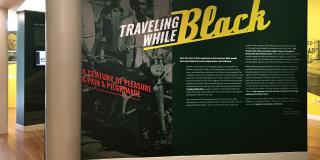
Migrations
Installation Image
The Great Migration, one of the largest movements of human beings in history, meant Black people from the South and Caribbean seeking their way north and west— for jobs, for community, for safety, and sometimes simply for a sense of adventure.
Many settled in Harlem, leading The New York Public Library’s 135th Street Branch to initiate its Negro Division in 1925, the predecessor to the current Schomburg Center for Research in Black Culture. At the center of the Harlem Renaissance, the Schomburg Center has served as a crossroads for migrants from the American South, African nations, and the Caribbean, bringing a unique mix of cultures and foodways to the Black Cultural Capital that is Harlem.
Such migrations didn’t stop at the United States border, however, as significant numbers of Black soldiers remained abroad after the war to explore Europe and Africa and the newfound Soviet Union, with Harlem Renaissance figures such as Langston Hughes, Claude McKay, Alain Locke, Augusta Savage, and Arturo Schomburg himself traveling abroad to create art, gain perspective, and enjoy freedoms they didn’t always find stateside. We return. We return from fighting. We return fighting, wrote W.E.B. DuBois about the dilemmas confronting those back from the war.
Back home, artist Jacob Lawrence used the Schomburg Center’s rich resources to inform his historic paintings on the Great Migration and the American Struggle, capturing the daily life of Black travelers headed north or simply headed to work on the subway. With the recent debates over immigration and refugees, we do well to remember the ways migration, exile, and establishing home has long been part of the African American experience—making a way out of no way.
Untitled (Man on Mule)
Bill Traylor
Tempera on Board
Cir. 1940s
Gift of Mr. & Mrs. Charles Shannon
Installation Image by HvA Design. Main Exhibition Gallery, Schomburg Center






